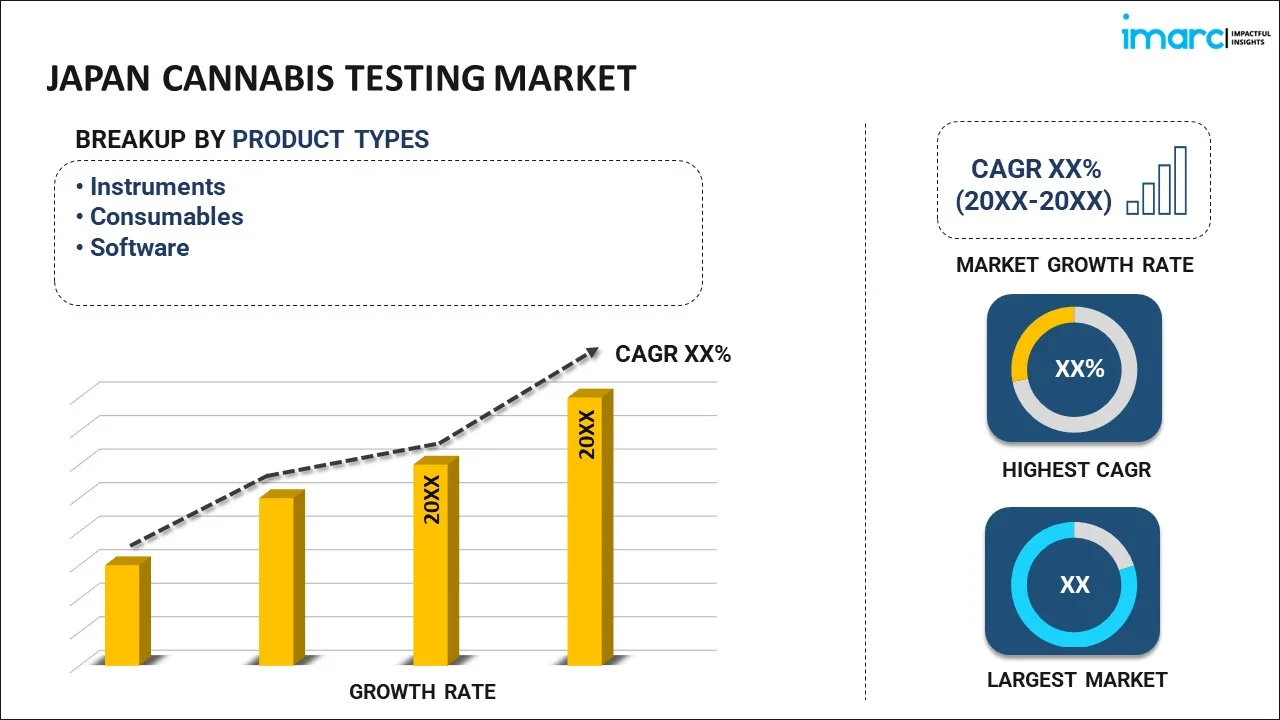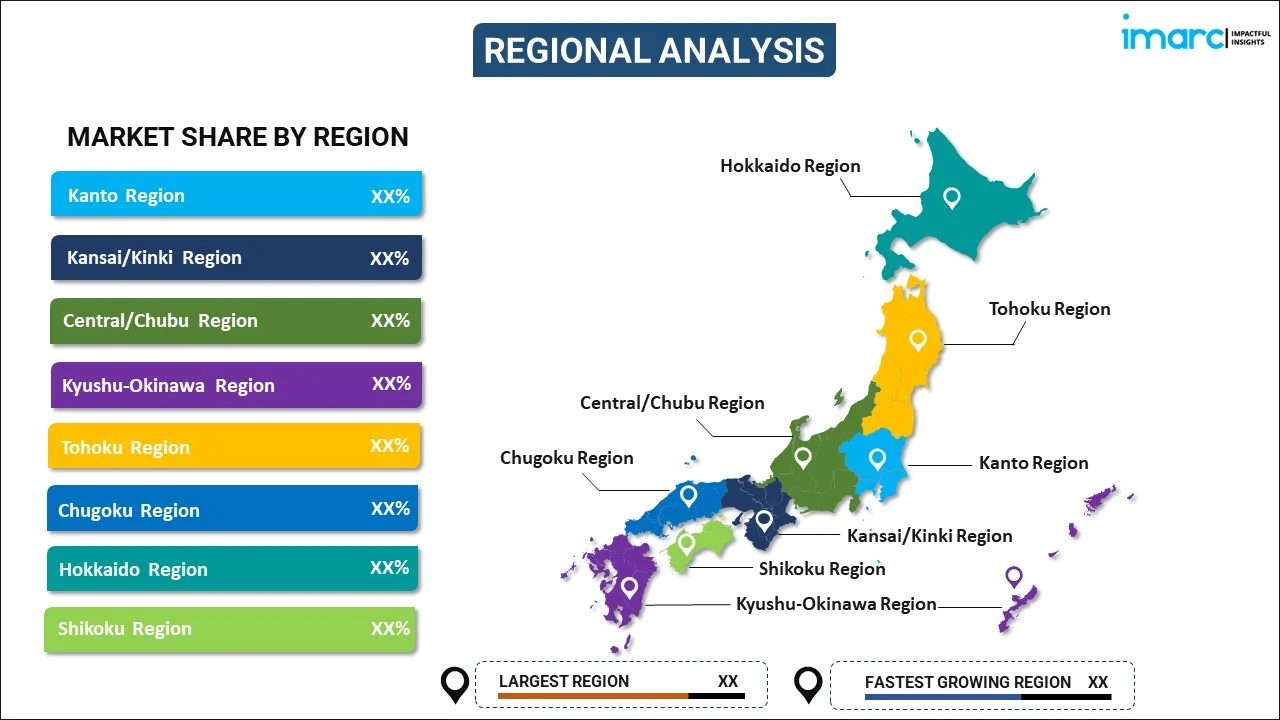
Japan Cannabis Testing Market Report by Product Type (Instruments, Consumables, Software), Test Type (Heavy Metal Testing, Microbial Analysis, Potency Testing, Residual Screening, and Others), End User (Cannabis Cultivators/Growers, Cannabis Drug Manufacturers, and Others), and Region 2025-2033
Market Overview:
Japan cannabis testing market size reached USD 35.0 Million in 2024. Looking forward, IMARC Group expects the market to reach USD 101.0 Million by 2033, exhibiting a growth rate (CAGR) of 11.4% during 2025-2033. The emerging regulatory frameworks ensuring product safety, quality, and compliance is primarily driving the market growth.
|
Report Attribute
|
Key Statistics
|
|---|---|
|
Base Year
|
2024 |
|
Forecast Years
|
2025-2033
|
|
Historical Years
|
2019-2024
|
| Market Size in 2024 | USD 35.0 Million |
| Market Forecast in 2033 | USD 101.0 Million |
| Market Growth Rate (2025-2033) | 11.4% |
Cannabis testing refers to the analytical process of examining cannabis products, such as marijuana and hemp, to assess their chemical composition and quality. It involves a comprehensive analysis of various compounds within the plant, including cannabinoids (e.g., THC and CBD), terpenes, residual solvents, pesticides, heavy metals, and microbial contaminants. The primary objective of cannabis testing is to ensure product safety and consistency, as well as to comply with regulatory requirements in regions where cannabis consumption is legal. By conducting rigorous testing, laboratories can provide valuable information to consumers, producers, and regulators, enabling them to make informed decisions about the quality, potency, and safety of cannabis products. This process plays a crucial role in the cannabis industry, promoting consumer confidence, responsible usage, and adherence to legal standards.
Japan Cannabis Testing Market Trends:
The Japan cannabis testing market is evolving as the nation explores the potential uses of cannabis for medicinal and industrial purposes. Cannabis testing in Japan primarily focuses on analyzing the chemical composition and quality of cannabis products, including marijuana and hemp. With growing interest in the therapeutic applications of cannabinoids like CBD, there's an increased need for accurate and reliable testing procedures to ensure product safety and compliance with regulations. Cannabis testing laboratories in Japan are at the forefront of conducting comprehensive analyses, covering aspects such as cannabinoid profiles, terpene content, residual solvents, pesticides, heavy metals, and microbial contaminants. As the country considers expanding its cannabis-related industries, the role of testing in maintaining product quality and consumer safety becomes increasingly vital. The Japan cannabis testing market is expected to see further development in response to the changing legal landscape and growing demand for high-quality cannabis products. In conclusion, the Japan cannabis testing market is evolving in response to changing attitudes towards cannabis and emerging regulatory frameworks. As Japan explores the potential uses of cannabis for medicinal and industrial purposes, rigorous testing procedures play a crucial role in ensuring product safety, quality, and compliance with evolving standards. The market is expected to experience growth as the nation continues to navigate the complex landscape of cannabis legalization and utilization.
Japan Cannabis Testing Market Segmentation:
IMARC Group provides an analysis of the key trends in each segment of the market, along with forecasts at the country level for 2025-2033. Our report has categorized the market based on product type, test type, and end user.
Product Type Insights:

- Instruments
- Chromatography Instruments
- Spectroscopy Instruments
- Consumables
- Software
The report has provided a detailed breakup and analysis of the market based on the product type. This includes instruments (chromatography instruments and spectroscopy instruments), consumables, and software.
Test Type Insights:
- Heavy Metal Testing
- Microbial Analysis
- Potency Testing
- Residual Screening
- Others
A detailed breakup and analysis of the market based on the test type have also been provided in the report. This includes heavy metal testing, microbial analysis, potency testing, residual screening, and others.
End User Insights:
- Cannabis Cultivators/Growers
- Cannabis Drug Manufacturers
- Others
The report has provided a detailed breakup and analysis of the market based on the end user. This includes cannabis cultivators/growers, cannabis drug manufacturers, and others.
Regional Insights:

- Kanto Region
- Kansai/Kinki Region
- Central/ Chubu Region
- Kyushu-Okinawa Region
- Tohoku Region
- Chugoku Region
- Hokkaido Region
- Shikoku Region
The report has also provided a comprehensive analysis of all the major regional markets, which include Kanto Region, Kansai/Kinki Region, Central/ Chubu Region, Kyushu-Okinawa Region, Tohoku Region, Chugoku Region, Hokkaido Region, and Shikoku Region.
Competitive Landscape:
The market research report has also provided a comprehensive analysis of the competitive landscape in the market. Competitive analysis such as market structure, key player positioning, top winning strategies, competitive dashboard, and company evaluation quadrant has been covered in the report. Also, detailed profiles of all major companies have been provided.
Japan Cannabis Testing Market Report Coverage:
| Report Features | Details |
|---|---|
| Base Year of the Analysis | 2024 |
| Historical Period | 2019-2024 |
| Forecast Period | 2025-2033 |
| Units | Million USD |
| Scope of the Report | Exploration of Historical Trends and Market Outlook, Industry Catalysts and Challenges, Segment-Wise Historical and Future Market Assessment:
|
| Product Types Covered |
|
| Test Types Covered | Heavy Metal Testing, Microbial Analysis, Potency Testing, Residual Screening, Others |
| End Users Covered | Cannabis Cultivators/Growers, Cannabis Drug Manufacturers, Others |
| Regions Covered | Kanto Region, Kansai/Kinki Region, Central/ Chubu Region, Kyushu-Okinawa Region, Tohoku Region, Chugoku Region, Hokkaido Region, Shikoku Region |
| Customization Scope | 10% Free Customization |
| Post-Sale Analyst Support | 10-12 Weeks |
| Delivery Format | PDF and Excel through Email (We can also provide the editable version of the report in PPT/Word format on special request) |
Key Questions Answered in This Report:
- How has the Japan cannabis testing market performed so far and how will it perform in the coming years?
- What has been the impact of COVID-19 on the Japan cannabis testing market?
- What is the breakup of the Japan cannabis testing market on the basis of product type?
- What is the breakup of the Japan cannabis testing market on the basis of test type?
- What is the breakup of the Japan cannabis testing market on the basis of end user?
- What are the various stages in the value chain of the Japan cannabis testing market?
- What are the key driving factors and challenges in the Japan cannabis testing?
- What is the structure of the Japan cannabis testing market and who are the key players?
- What is the degree of competition in the Japan cannabis testing market?
Key Benefits for Stakeholders:
- IMARC’s industry report offers a comprehensive quantitative analysis of various market segments, historical and current market trends, market forecasts, and dynamics of the Japan cannabis testing market from 2019-2033.
- The research report provides the latest information on the market drivers, challenges, and opportunities in the Japan cannabis testing market.
- Porter's five forces analysis assist stakeholders in assessing the impact of new entrants, competitive rivalry, supplier power, buyer power, and the threat of substitution. It helps stakeholders to analyze the level of competition within the Japan cannabis testing industry and its attractiveness.
- Competitive landscape allows stakeholders to understand their competitive environment and provides an insight into the current positions of key players in the market.
Need more help?
- Speak to our experienced analysts for insights on the current market scenarios.
- Include additional segments and countries to customize the report as per your requirement.
- Gain an unparalleled competitive advantage in your domain by understanding how to utilize the report and positively impacting your operations and revenue.
- For further assistance, please connect with our analysts.
 Inquire Before Buying
Inquire Before Buying
 Speak to an Analyst
Speak to an Analyst
 Request Brochure
Request Brochure
 Request Customization
Request Customization




.webp)




.webp)












